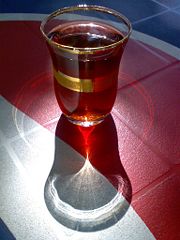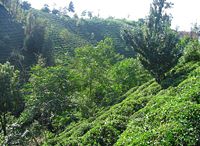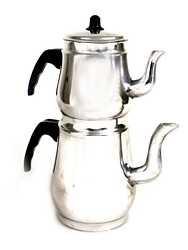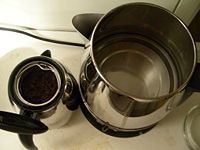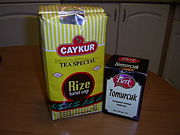Difference between revisions of "Turkish tea" - New World Encyclopedia
| Line 35: | Line 35: | ||
==Tea gardens== | ==Tea gardens== | ||
| − | ''Çay Bahcesi'' or "tea gardens" are popular all over Turkey, as relaxed environments where friends and colleagues can enjoy companionship while drinking Turkish tea. In rural areas particularly, tea gardens may be separate for men and for families; in larger cities, though, such segregation is uncommon. In large cities and [[tourism|tourist]] areas, all are welcome, including many foreigners. In [[Istanbul]] in particular, tea gardens gained popularity in the 1950s, becoming a popular place for families to go for social outings.<ref name=pelin/> | + | ''Çay Bahcesi'' or "tea gardens" are popular all over Turkey, as relaxed environments where friends and colleagues can enjoy companionship while drinking Turkish tea. In rural areas particularly, tea gardens may be separate for men and for families; in larger cities, though, such segregation is uncommon. In large cities and [[tourism|tourist]] areas, all are welcome, including many foreigners. No [[alcoholic beverage|alcohol]] is served in tea gardens; tea is the main drink although [[Turkish coffee|coffee]] is also served. In [[Istanbul]] in particular, tea gardens gained popularity in the 1950s, becoming a popular place for families to go for social outings.<ref name=pelin/> |
The Turkish tea garden is very different from the garden of a Japanese [[tea house]], which was developed to provide a quiet and serene environment for the [[Japanese tea ceremony]]. By contrast, Turkish tea gardens are "hubs of social activity with kids running around, music playing, and lively conversation among various groups from students, to businessmen to retirees and foreigners."<ref name=pelin>Pelin Aylangan, [http://www.turkishculture.org/pages.php?ParentID=11&ID=53 Turkish Tea,] Turkish Cultural Foundation, 2006. Retrieved February 24, 2009.</ref> | The Turkish tea garden is very different from the garden of a Japanese [[tea house]], which was developed to provide a quiet and serene environment for the [[Japanese tea ceremony]]. By contrast, Turkish tea gardens are "hubs of social activity with kids running around, music playing, and lively conversation among various groups from students, to businessmen to retirees and foreigners."<ref name=pelin>Pelin Aylangan, [http://www.turkishculture.org/pages.php?ParentID=11&ID=53 Turkish Tea,] Turkish Cultural Foundation, 2006. Retrieved February 24, 2009.</ref> | ||
[[Image:Packs of Turkish tea.JPG|thumb|right|180 px|Packs of Turkish tea (Rize turist cayi and Tomurcuk).]] | [[Image:Packs of Turkish tea.JPG|thumb|right|180 px|Packs of Turkish tea (Rize turist cayi and Tomurcuk).]] | ||
| + | |||
==Turkish herbal tea== | ==Turkish herbal tea== | ||
In Turkey, [[herbal tea]]s are also popular, with [[apple]] ''(elma çayı)'', [[rose hip]] ''(kuşburnu çayı)'', and [[Tilia|linden]] flower ''(ıhlamur çayı)'' being the most popular flavors. Sage tea (''ada çayı'', also called "island tea") is most popular in the [[Mediterranean]] coastal region. | In Turkey, [[herbal tea]]s are also popular, with [[apple]] ''(elma çayı)'', [[rose hip]] ''(kuşburnu çayı)'', and [[Tilia|linden]] flower ''(ıhlamur çayı)'' being the most popular flavors. Sage tea (''ada çayı'', also called "island tea") is most popular in the [[Mediterranean]] coastal region. | ||
Revision as of 17:37, 24 February 2009
Turkish tea (Turkish: çay) is a type of tea originating in Turkey and popular among most people living in the Turkic speaking world and the Horn of Africa. In its method of preparation and service it resembles Russian tea more than the British or Chinese forms. Turks make use a tea maker similar to a Russian samovar to brew their tea, which is served in glasses rather than cups. Turkish tea is as popular if not more so than Turkish coffee, particularly among younger people in Turkey. Turkey as also a significant producer of tea, primarily from the Rize province which borders the Black Sea.
Introduction
Turkish tea, called çay, a form of black tea, is produced on the eastern Black Sea coast, which has a mild climate with high precipitation and fertile soil. Within Turkey, the tea is usually known as Rize tea and comes from the Rize province.
The Turks developed their own way of making and drinking the black tea which became a way of life for Turkish culture. Wherever people go in Turkey, tea or coffee will be offered as a sign of friendship and hospitality, at homes, bazaars and restaurants, before or after a meal.
Turkey one of the largest tea markets in the world, with consumption reckoned as the highest per capita in 2004.[1] The way tea is prepared and drunk in Turkey is somewhat unique, similar to Turkish coffee in its strength and caffeine content, related to that of the Russian method using a samovar.
History
Despite its popularity, tea became the widely consumed beverage of choice in Turkey relatively recently, in the 1930s. When the Ottoman Empire collapsed in 1923, the Turks lost Mocha in Yemen, and coffee became an expensive import. The nation's founder, Atatürk, encouraged tea as an alternative to Turkish coffee, which had become expensive and at times unavailable in the aftermath of World War I. Coffee had to be imported, mainly from Brazil, whereas tea was easily sustainable domestically. The Turks turned to tea.
Finding that the Rize Province on the eastern Black Sea coast had an appropriately mild climate with high precipitation and fertile soil, the Turks began to produce their own tea, Rize tea. Rize tea or Çay is a form of black tea and produces a crystal clear liquid that is mahogany in color. Brewed for a long time, at least 15 minutes, it is then mixed with hot water and sweetened with sugar to taste. This Turkish tea became popular everywhere, drunk at any time.[2] As in other Muslim countries, tea (and to some extent still coffee) takes the place of alcohol as the social beverages.
In 2004 Turkey produced 205,500 tonnes of tea (6.4 percent of the world's total tea production), which made it one of the largest tea markets in the world.[3] Furthermore, in 2004, Turkey had the highest per capita tea consumption in the world, at 2.5 kg per person—followed by the United Kingdom (2.1 kg per person).[1]
Preparation
Turkish tea is typically prepared using two stacked kettles (çaydanlık) especially designed for tea preparation. Water is brought to a boil in the larger lower kettle and then some of the water is used to fill the smaller kettle on top and steep several spoons of loose tea leaves, producing a very strong tea. When served, the remaining water is used to dilute the tea on an individual basis, giving each consumer the choice between strong (Turkish: koyu; literally "dark") or weak (Turkish: açık; literally "light"). Tea is drunk from small glasses to enjoy it hot in addition to show its color, with lumps of sugar.
Turkish tea is full-flavored and too strong to be served in large cups, thus it is always offered in small tulip-shaped glasses which are usually held by the rim, in order to save the drinker's fingertips from being burned, as the tea is served very hot. Turkish tea drinkers often add sugar, but milk is not traditional.
Turkish tea is served in cafés by a çaycı (tea-waiters). Serious tea-drinking Turks often go to a tea house or Çay Bahcesi (tea garden) where they serve it with a samovar (Turkish: samever) or urn, and patrons can refill their glasses themselves as much as they want.
Tea gardens
Çay Bahcesi or "tea gardens" are popular all over Turkey, as relaxed environments where friends and colleagues can enjoy companionship while drinking Turkish tea. In rural areas particularly, tea gardens may be separate for men and for families; in larger cities, though, such segregation is uncommon. In large cities and tourist areas, all are welcome, including many foreigners. No alcohol is served in tea gardens; tea is the main drink although coffee is also served. In Istanbul in particular, tea gardens gained popularity in the 1950s, becoming a popular place for families to go for social outings.[4]
The Turkish tea garden is very different from the garden of a Japanese tea house, which was developed to provide a quiet and serene environment for the Japanese tea ceremony. By contrast, Turkish tea gardens are "hubs of social activity with kids running around, music playing, and lively conversation among various groups from students, to businessmen to retirees and foreigners."[4]
Turkish herbal tea
In Turkey, herbal teas are also popular, with apple (elma çayı), rose hip (kuşburnu çayı), and linden flower (ıhlamur çayı) being the most popular flavors. Sage tea (ada çayı, also called "island tea") is most popular in the Mediterranean coastal region.
Notes
- ↑ 1.0 1.1 Euromonitor International, Turkey: Second biggest tea market in the world. Retrieved February 22, 2009.
- ↑ [Debbie Kwiatoski, Turkish Tea: Brewing and Drinking Tea in Turkey. Suite101.com, Jul 4, 2007. Retrieved February 24, 2009.
- ↑ Food and Agriculture Organization of the United Nations, World tea production reaches new highs FAO Newsroom, July 14, 2005. Retrieved February 22, 2009.
- ↑ 4.0 4.1 Pelin Aylangan, Turkish Tea, Turkish Cultural Foundation, 2006. Retrieved February 24, 2009.
ReferencesISBN links support NWE through referral fees
- Gautier, Lydia. 2006. Tea: Aromas and Flavors Around the World. San Francisco, CA: Chronicle Books. ISBN 978-0811856829
- Heiss, Mary Lou, and Robert J. Heiss. 2007. The Story of Tea: A Cultural History and Drinking Guide. Berkeley, CA: Ten Speed Press. ISBN 978-1580087452
- Pettigrew, Jane, and Bruce Richardson. 2008. The New Tea Companion. Perryville, KY: Benjamin Press. ISBN 978-0979343179
- Kwiatoski, Debbie. Turkish Tea: Brewing and Drinking Tea in Turkey. Suite101.com, Jul 4, 2007. Retrieved February 24, 2009.
- Aylangan, Pelin. Turkish Tea, Turkish Cultural Foundation, 2006. Retrieved February 24, 2009.
External links
| ||||
| Black tea | Blended and flavored teas | Chinese tea | Earl Grey tea | Green tea | Herbal tea | Lapsang souchong | Masala chai | Mate tea | Mint tea | Oolong tea | Turkish tea | White tea | Yellow tea | ||||
| Tea culture | Related to tea | |||
| China | India | Japan | Korea | Morocco | Russia | United Kingdom | United States | Samovar | Tea house | Teapot | Tea set | |||
Credits
New World Encyclopedia writers and editors rewrote and completed the Wikipedia article in accordance with New World Encyclopedia standards. This article abides by terms of the Creative Commons CC-by-sa 3.0 License (CC-by-sa), which may be used and disseminated with proper attribution. Credit is due under the terms of this license that can reference both the New World Encyclopedia contributors and the selfless volunteer contributors of the Wikimedia Foundation. To cite this article click here for a list of acceptable citing formats.The history of earlier contributions by wikipedians is accessible to researchers here:
The history of this article since it was imported to New World Encyclopedia:
Note: Some restrictions may apply to use of individual images which are separately licensed.

